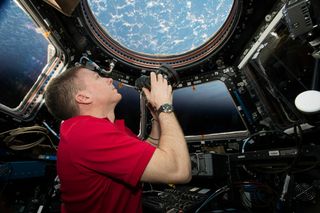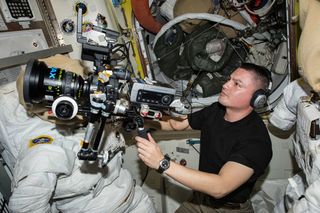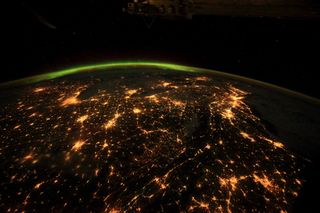Earth Is 'A Beautiful Planet' from an Astronaut's-Eye-View

Most people will never have the experience of flying high over Earth in a spacecraft and seeing the planet's atmosphere, oceans and landmasses unspooling far below.
But now, Earthbound humans can look down on their planet in a way that emulates an astronaut's perspective more closely than anything ever seen before, thanks to "A Beautiful Planet," a new film created in IMAX 3D.
The film uses footage shot by NASA astronauts onboard the International Space Station (ISS). "A Beautiful Planet" is the first movie to use digital technology in space to capture glimpses of Earth and scenes of daily life inside the ISS at IMAX resolution, for projecting on a large-scale theater screen in 3D. [See Spectacular Photos of Earth from 'A Beautiful Planet']
Even the astronauts who shot the movie agreed that seeing the IMAX footage was the next best thing to living in space and peering out of the ISS windows. Kjell Lindgren, one of the film's astronaut cinematographers, told Live Science during a roundtable discussion that IMAX's immersive environment is very similar to what he saw firsthand.
"Having that scene occupy your entire field of view is the closest you can come to actually experiencing it," Lindgren said.

"Mini film school"
To prepare for shooting, the astronauts worked closely with Toni Myers, the film's director and editor, and cinematographer James Neihouse in "a mini film school," Lindgren said. The production team familiarized the astronauts with the technical requirements for shooting IMAX and showed them how to use visual elements like composition, camera angles and movement to share their unique view of Earth and their daily routines.
The scale of IMAX projection meant the camera-toting astronauts had to be exceptionally careful with their exposure, focus and steadiness, Neihouse told Live Science.
Get the Space.com Newsletter
Breaking space news, the latest updates on rocket launches, skywatching events and more!
"Small mistakes become huge mistakes on a big screen," he said.
Myers provided a list of locations on Earth and of ISS scenes — such as sleeping, performing experiments and celebrating Christmas — that she wanted the astronauts to capture. But the scenes weren't scripted, and the astronauts were encouraged to be on the lookout for interesting moments that might arise unexpectedly.
This is easier said than done, though, said astronaut Terry Virts, who captured stills and footage for the film and who has taken more than 500,000 photos in space (more than any other astronaut). Virts explained that the speed at which the ISS travels — 5 miles (8 meters) per second — made capturing some of their Earth scenes especially challenging, leaving the astronauts mere moments to grab shots as the ISS hurtled past.
"If you see it and think about it, it's too late," Virts said.
The film is Myers' fourth IMAX movie shot in space, following "Hubble 3D" (2010), "Space Station 3D" (2002) and "Blue Planet" (1990). Improvements in camera capabilities meant that her shot list for the astronauts could include nighttime scenes that would not have been possible to capture using earlier technology: spectacular auroras, flashes from lightning storms and signs of human activity — the sprawl of city lights and fishing boats. [Earth Pictures: Iconic Images of Earth from Space]

A sobering sight
But when viewed from the ISS, some signs of human activity revealed a devastating impact on the planet.
Across the length of Madagascar a brown expanse stretched where forests once grew. Plumes of smoke emerged from South American rainforests as swatches of trees burned. Parched landscapes in the American Southwest showed scars left by drought and climbing temperatures.
Climatologist and Director of the NASA Goddard Institute for Space Studies (GISS) Gavin Schmidt is well-acquainted with the evidence of recent and rapid climate change on Earth, but he was still taken aback when he saw the film, he told Live Science. [What a View: Amazing Astronaut Images of Earth]
"I knew it was bad. I didn't know it was that bad," Schmidt said. "That kind of imagery, that's powerful. You see the fingerprint of deforestation, of ice-sheet collapse, pollution from runoff, the bare hillsides of Madagascar."
However, alongside these troubling images, there was still room for optimism, he said.
"The beauty of the system as a whole tells people maybe we can change that, maybe we can have a different fingerprint," Schmidt said.
And perhaps in watching the ways that astronauts interact with the ISS, viewers might learn some lessons about how to treat the Earth, Lindgren suggested.
"We live on the ISS. We spend an inordinate amount of time up there taking care of it, because we recognize that it protects us from the cold, harsh void of space. Look at the Earth from that perspective — it provides us with food, water, protection from radiation. And we don't spend nearly as much time taking care of it as we do on the space station," Lindgren said.
Myers said using the film to help people recognize the similarities between life on the ISS and living on "spaceship Earth" was a goal from the beginning.
"If kids can understand what it takes to keep a crew alive in a closed system like that, and understand that the Earth is exactly the same thing for billions of people — that's the analogy I wanted to pursue," she said.

Awe and wonder
Lindgren told Live Science that seeing the vastness of Earth from space is life-changing. And in fact, many astronauts have described this profoundly transformative effect. In a recent study, a team of psychologists investigated the emotions described by numerous space travelers, to better understand the mechanisms that inspire these "blissful moments" and how similar emotions manifest in people who have never been to space.
Could an immersive IMAX view of Earth allow more people to share that life-changing perspective? The filmmakers said they believe it can.
"When you look down on Earth, you see it's unique — and fragile," Lindgren said.
"I would hope that we inspire our audience of all ages, but particularly young people, about what a beautiful place our planet is," Myers added, "especially when you see it from this unique perspective. And I would like to inspire them to take good care of it and look for solutions to some of the problems we have."
Would-be astronauts can embark on their own "voyage" into near-Earth orbit when "A Beautiful Planet" opens in IMAX theaters on April 29.
Follow Mindy Weisberger on Twitter and Google+. Follow us @livescience, Facebook & Google+. Original article on Live Science.
Join our Space Forums to keep talking space on the latest missions, night sky and more! And if you have a news tip, correction or comment, let us know at: community@space.com.


